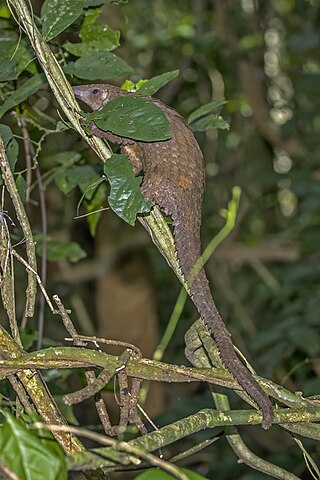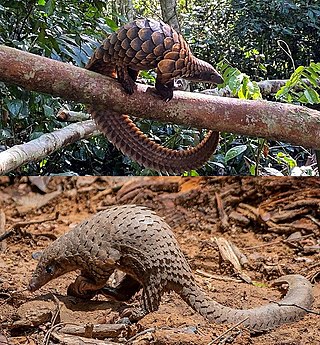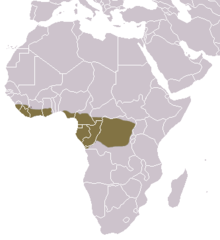
Pangolins, sometimes known as scaly anteaters, are mammals of the order Pholidota. The one extant family, the Manidae, has three genera: Manis, Phataginus, and Smutsia. Manis comprises four species found in Asia, while Phataginus and Smutsia include two species each, all found in sub-Saharan Africa. These species range in size from 30 to 100 cm. A number of extinct pangolin species are also known. In September 2023, nine species were reported.

The ground pangolin, also known as Temminck's pangolin, Cape pangolin or steppe pangolin is a species of pangolin from genus Smutsia of subfamily Smutsiinae the within family Manidae. It is one of four species of pangolins which can be found in Africa, and the only one in southern and eastern Africa. The animal was named for the Dutch zoologist Coenraad Jacob Temminck.

Manis ("spirit") is a genus of South Asian and East Asian pangolins, the Asiatic pangolins, from subfamily Maninae, within family Manidae.

Manidae ("spirits") is the only extant family of pangolins from superfamily Manoidea. This family comprises three genera, as well as extinct Fayum pangolin.

The Indian pangolin, also called thick-tailed pangolin and scaly anteater, is a pangolin native to the Indian subcontinent. Like other pangolins, it has large, overlapping scales on its body which act as armour. The colour of its scales varies depending on the colour of the earth in its surroundings. It can also curl itself into a ball as self-defence against predators such as the tiger. It is an insectivore feeding on ants and termites, digging them out of mounds and logs using its long claws, which are as long as its fore limbs. It is nocturnal and rests in deep burrows during the day.

The giant pangolin is a species of pangolins from genus Smutsia of subfamily Smutsiinae within the family Manidae. It is the largest living species of pangolins. Members of the species inhabit Africa with a range stretching along the equator from West Africa to Uganda. It subsists almost entirely on ants and termites.

The Sunda pangolin, also known as the Malayan or Javan pangolin, is a species of pangolin.

The southern tamandua, also called the collared anteater or lesser anteater, is a species of anteater from South America and the island of Trinidad in the Caribbean. It is a solitary animal found in many habitats, from mature to highly disturbed secondary forests and arid savannas. It feeds on ants, termites, and bees. Its very strong foreclaws can be used to break insect nests or to defend itself.

Eurotamandua is an extinct genus of mammal from extinct family Eurotamanduidae that lived during the middle Eocene.

Tamandua is a genus of anteaters in the Myrmecophagidae family with two species: the southern tamandua and the northern tamandua. They live in forests and grasslands, are semiarboreal, and possess partially prehensile tails. They mainly eat ants and termites, but they occasionally eat bees, beetles, and insect larvae. In captivity, they will eat fruits and meat. They have no teeth and depend on their powerful gizzards to break down their food.

The Chinese pangolin is a pangolin native to the northern Indian subcontinent, northern parts of Southeast Asia and southern China. It has been listed as Critically Endangered on the IUCN Red List since 2014, as the wild population is estimated to have declined by more than 80% in three pangolin generations, equal to 21 years. It is threatened by poaching for the illegal wildlife trade.

The tree pangolin is one of eight extant species of pangolins, and is native to equatorial Africa. Also known as the white-bellied pangolin or three-cusped pangolin, it is the most common of the African forest pangolins.

The Philippine pangolin or Palawan pangolin, also locally known as balintong, is a pangolin species endemic to the Palawan province of the Philippines. Its habitat includes primary and secondary forests, as well as surrounding grasslands. This species is moderately common within its limited range, but is at risk due to heavy hunting because of its valued scales and meat. This species is distinguished from the closely related Sunda pangolin by its smaller body-to-tail ratio, smaller scales, and a shorter head. It is listed as Critically Endangered by the IUCN, and Critically Endangered by the Palawan Council for Sustainable Development (PCSD).
Gigantorhynchida is an order containing a single family, Gigantorhynchidae of parasitic worms that attach themselves to the intestinal wall of terrestrial vertebrates. Gigantorhynchida contains the following three genera:

African tree pangolin (Phataginus) is a genus of African pangolins from subfamily small African pangolins (Phatagininae), within family Manidae. Its members are the more arboreal of the African pangolins.

African ground pangolin is a genus of pangolins from subfamily Smutsiinae within family Manidae. It was formerly considered a subgenus of genus Manis. Its members are the more terrestrial of the African pangolins. In past, this genus was also present in Europe.

The pangolin trade is the illegal poaching, trafficking, and sale of pangolins, parts of pangolins, or pangolin-derived products on the black market. Pangolins are believed to be the world's most trafficked mammal, accounting for as much as 20% of all illegal wildlife trade. According to the International Union for Conservation of Nature (IUCN), more than a million pangolins were poached in the decade prior to 2014.
Pangolin, sometimes known as a scaly anteater, is a mammal of the order Pholidota -one extant family, Manidae; more specifically:
Intraproboscis is a monotypic genus of acanthocephalans that infest African black-bellied pangolin in the Central African Republic. Its body consists of a proboscis armed with hooks which it uses to pierce and hold the gut wall of its host, and a long trunk. It contains a single species, Intraproboscis sanghae. This genus resembles species in the genus Mediorhynchus but is characterized by infesting a mammal instead of birds, and having a simple proboscis receptacle that is completely suspended within the proboscis, the passage of the retractor muscles through the receptacle into the body cavity posteriorly, absence of neck, presence of a parareceptacle structure, and a uterine vesicle. The proboscis is armed with 34–36 rows of 6 to 7 hooks anteriorly and 15–17 spinelike hooks posteriorly which are used to attach themselves to the intestines of the host. The female worms are up to 180 millimetres long, virtually all of which is the trunk, and 2 millimetres wide.





















